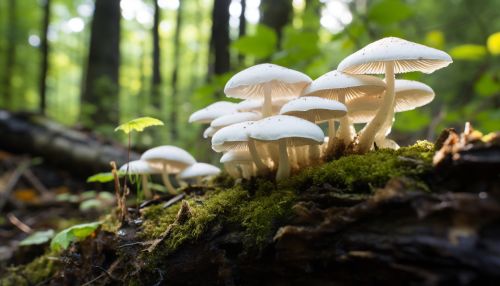Mechanisms of Pollutant Degradation by White-Rot Fungi
Introduction
White-rot fungi are a group of basidiomycete fungi that have the unique ability to degrade a wide range of pollutants. These organisms are known for their ability to break down lignin, a complex organic molecule that gives wood its strength. This ability has been harnessed in the field of bioremediation, where white-rot fungi are used to break down pollutants in contaminated environments.


Mechanisms of Pollutant Degradation
White-rot fungi degrade pollutants through a process known as oxidative degradation. This process involves the production of extracellular enzymes and reactive oxygen species that break down complex organic molecules into simpler compounds. The main enzymes involved in this process are lignin peroxidase, manganese peroxidase, and laccase.
Lignin Peroxidase
Lignin peroxidase (LiP) is an enzyme that breaks down lignin and other complex organic molecules. It does this by oxidizing the non-phenolic structures of these molecules, leading to their breakdown. LiP is particularly effective at degrading high-molecular-weight pollutants, including polycyclic aromatic hydrocarbons (PAHs) and dioxins.
Manganese Peroxidase
Manganese peroxidase (MnP) is another enzyme produced by white-rot fungi. MnP oxidizes Mn2+ ions to Mn3+, which in turn oxidizes phenolic structures in lignin and other organic molecules. MnP is capable of degrading a wide range of pollutants, including PAHs, phenols, and dyes.
Laccase
Laccase is a multi-copper oxidase that oxidizes phenolic and non-phenolic compounds. It is capable of degrading a wide range of pollutants, including PAHs, phenols, dyes, and industrial effluents.
Applications of White-Rot Fungi in Bioremediation
Due to their ability to degrade a wide range of pollutants, white-rot fungi have been used in various bioremediation applications. These include the treatment of industrial effluents, soil remediation, and the degradation of synthetic dyes.
Treatment of Industrial Effluents
Industrial effluents often contain a wide range of pollutants, including phenols, dyes, and PAHs. White-rot fungi have been used to treat these effluents, with significant reductions in pollutant concentrations observed.
Soil Remediation
White-rot fungi have also been used in soil remediation projects. These fungi can degrade pollutants in soil, including PAHs, pesticides, and heavy metals. This makes them a valuable tool in the remediation of contaminated soils.
Degradation of Synthetic Dyes
Synthetic dyes are a major source of water pollution, particularly in regions with a large textile industry. White-rot fungi can degrade these dyes, reducing their toxicity and making the water safe for discharge.
Challenges and Future Directions
While white-rot fungi have shown promise in the field of bioremediation, there are several challenges that need to be addressed. These include the slow growth rate of these fungi, their sensitivity to environmental conditions, and the need for more research to fully understand their degradation mechanisms.
Despite these challenges, the future of white-rot fungi in bioremediation looks promising. With further research and development, these organisms could play a key role in addressing some of our most pressing environmental challenges.
